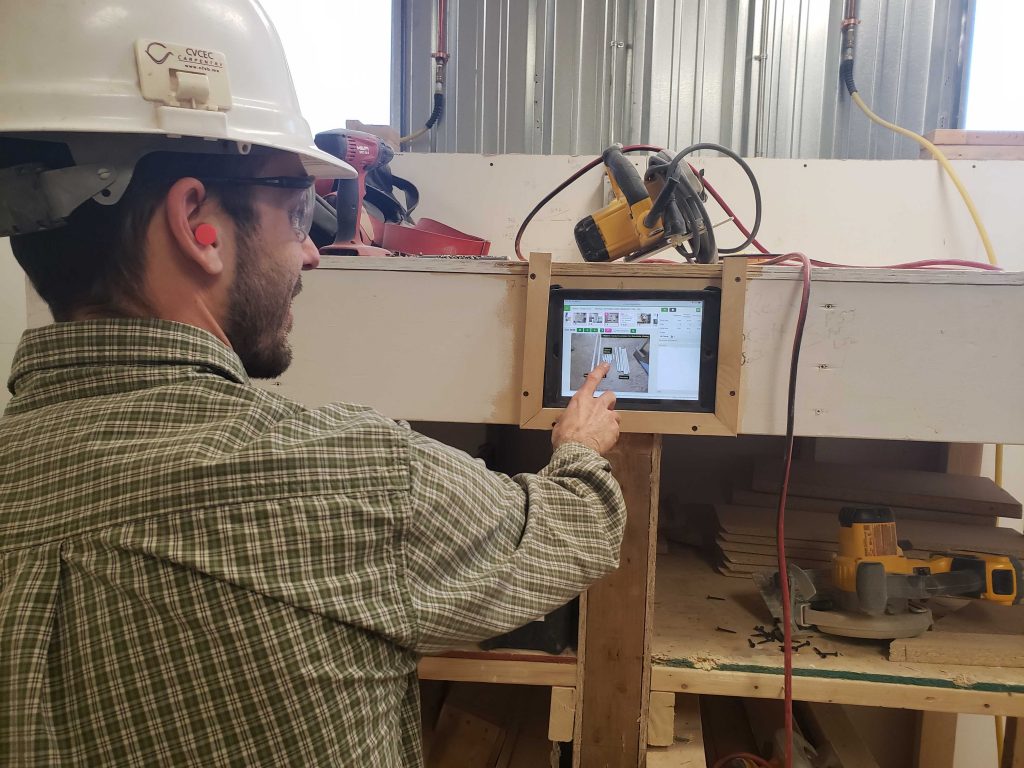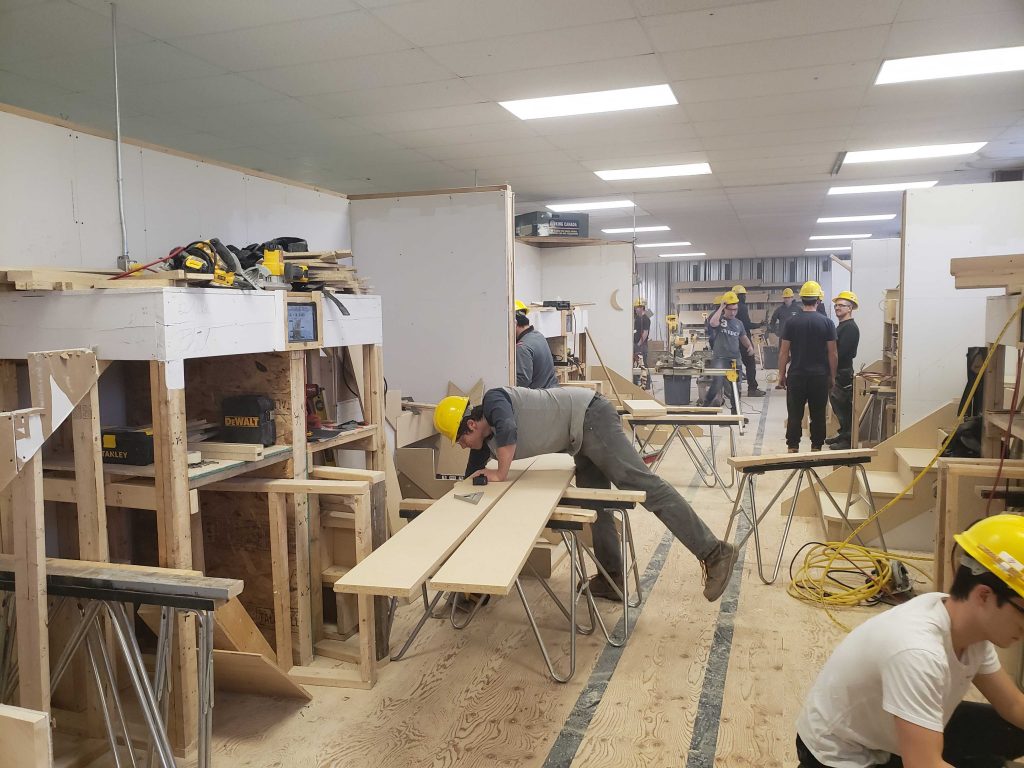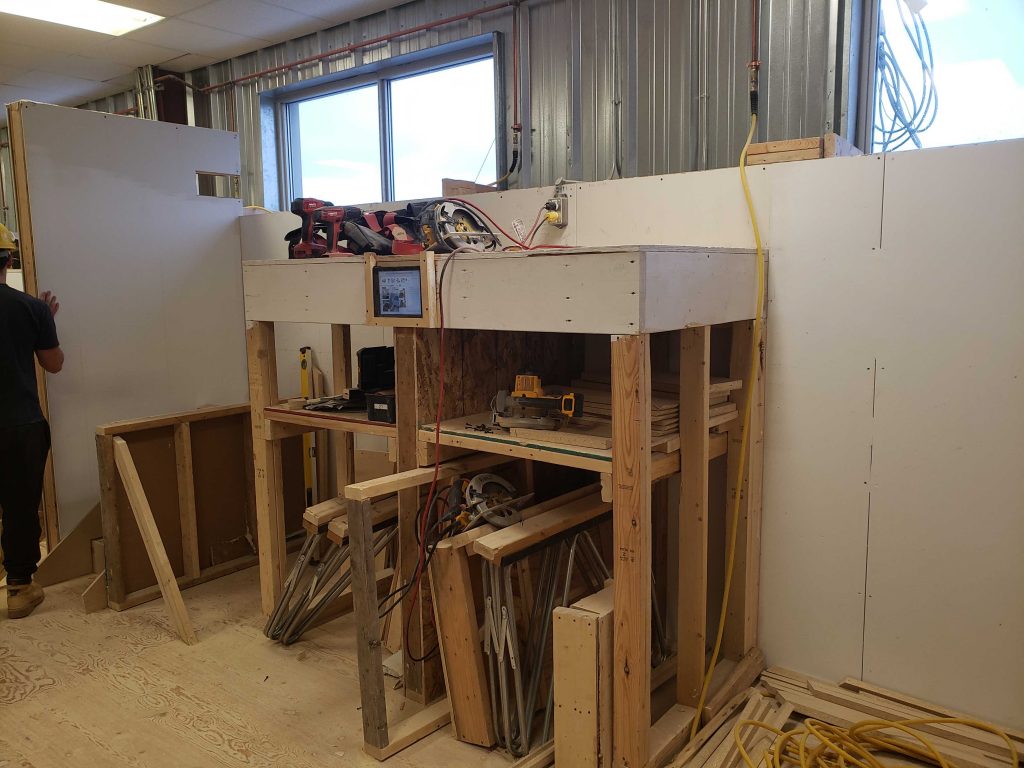LE TEXTE SUIVANT EST UN ARTICLE ORIGINAL DE VKS
10 raisons pour lesquelles cette école de menuiserie est passée de 11 à 88 escaliers par semestre
L'apprentissage d'une nouvelle compétence ou d'un nouveau métier prend du temps. Mais que se passerait-il si vous pouviez accélérer votre apprentissage et acquérir des connaissances approfondies en deux fois moins de temps ? C'est exactement ce qui s'est passé dans le cadre du programme de menuiserie de la Centre d'éducation des adultes et de formation professionnelle Châteauguay Valley (CVCEC). Avant VKSAinsi, un enseignant passerait beaucoup de temps à montrer à un groupe de 22 étudiants comment construire un escalier en un semestre de 120 heures. En plus de ne pas laisser beaucoup de temps à l'enseignant pour apporter un soutien individuel à chaque élève afin qu'il apprenne correctement, l'enseignant ne peut pas se contenter d'enseigner à ses élèves. charpenterieMais cela laissait aussi une grande place à l'erreur. Des informations clés pouvaient être mal interprétées ou perdues lorsque le cours était dispensé selon la méthode typique du "montrer et raconter".
L'utilisation de la VKS Les étudiants inscrits au programme de formation à l'enseignement supérieur ont accès à des instructions numériques étape par étape sur des tablettes. programme de menuiserie ont pu passer de la construction de 11 escaliers à celle de 88 escaliers dans le même laps de temps qu'auparavant, sans compromettre leur apprentissage ou la qualité de leur production. Nous avons rencontré Jovan-David Mercier-Montminy, professeur de menuiserie au CVCEC, pour savoir comment VKS a aidé les élèves à fabriquer 8 fois plus d'escaliers qu'auparavant.
1. VKS L'outil pratique
Vu de l'extérieur, un projet semble toujours plus facile qu'il ne l'est en réalité. Comme l'a souligné Jovan, "il semble très simple de construire un escalier parce qu'il y a cinq marches. En réalité, il faut effectuer 100 actions. Et pour les apprentis qui n'ont pas l'habitude de construire des escaliers, ces 100 étapes sont une montagne à mémoriser".
Il en va de même pour toutes les industries, qu'il s'agisse d'industries à grand volume et à faible mixité, comme l'industrie électronique, ou d'industries à faible volume et à forte mixité, comme l'industrie médicale. En ce qui concerne l'enseignement de la menuiserie, "il s'agit essentiellement de la manière dont nous pouvons exprimer des concepts en images et donner toutes les spécifications et les lignes directrices pour un projet pratique. La VKS est l'outil pratique qui nous aide vraiment dans la partie concrète de notre travail", a-t-il ajouté.
2. Facile à mettre en œuvre pour une personne peu technicienne
Jovan a expliqué que l'un des plus grands avantages du logiciel VKS est de pouvoir l'utiliser sans être, comme il l'a dit, "un technicien". L'enseignement est son point fort, mais lorsqu'il s'agit de technologie, il est important pour lui d'utiliser un logiciel qui fonctionne intuitivement avec lui.
Comme ses collègues et ses élèves ne sont pas très au fait de la technologie, il est important pour eux d'utiliser des logiciels dont l'utilisation est intuitive. Sans aucune formation, Jovan a pu commencer à créer des instructions de travail numériques pour que ses élèves les utilisent et apprennent immédiatement la menuiserie. Même si des modifications doivent être apportées, elles le sont rapidement, sur plusieurs guides, en quelques tapotements du doigt ou clics de souris. "La convivialité, du point de vue de l'enseignant, du simple fait de pouvoir créer un document, est inégalée", a ajouté Jovan.
3. La valeur des annotations
Lorsqu'il a évoqué les avantages de l'utilisation de VKS en groupe et individuellement, Jovan s'est montré très enthousiaste à l'idée de mentionner l'utilisation des annotations. Plus précisément, il a déclaré : "Tout ce que j'ai à faire, c'est de prendre les photos et, en quelques heures seulement, je peux les annoter. Ensuite, mes élèves utilisent des iPads pour glisser d'une image à l'autre".
Plus important encore, il a noté qu'en utilisant VKS, ses élèves sont en mesure d'acquérir l'indépendance 100% et d'en bénéficier : "Ils sont indépendants, ils construisent simplement en suivant les plans de VKS". Il est important de considérer cet aspect dans le grand schéma du processus de formation ou de fabrication. Il vous suffit de mettre en place les instructions étape par étape une fois pour que vos étudiants ou vos employés puissent ensuite les utiliser à plusieurs reprises et dans tous les domaines. Mieux encore, la formation avec VKS est polyvalente et peut également être utilisée comme guide de formation sous forme de quiz.
4. Chaque élève se sent désormais mieux préparé
En fin de compte, tout se résume à la productivité. En raison de l'intensité de la description de toutes les étapes, 22 étudiants n'ont pu construire que 11 séries d'escaliers. Mais en utilisant VKS et en supprimant la plupart des interactions redondantes entre les enseignants et les étudiants, ils sont désormais en mesure de construire 88 escaliers au cours d'un semestre donné de 120 heures de cours. Plus précisément, les 22 étudiants qui construisaient 11 séries d'escaliers sont désormais capables de construire 88 séries d'escaliers, ce qui signifie qu'ils construisent 4 escaliers chacun.
Mieux encore, l'augmentation de la quantité s'est accompagnée d'une augmentation de la qualité. À la fin du semestre, les étudiants se sentent mieux préparés parce qu'ils ont eu l'occasion de réaliser le projet plus d'une fois. En construisant quatre escaliers chacun, les étudiants sont en mesure de se préparer de manière adéquate aux examens de fin de semestre.
5. Élimination de l'effet téléphone
Comme nous l'avons vu précédemment, VKS est un logiciel flexible qui peut être utilisé de différentes manières et c'est exactement ce que CVCEC a remarqué. Pour aider les élèves à apprendre la menuiserie, ils utilisent VKS à la fois en groupe et individuellement.
Dans les scénarios de groupe, en particulier, Jovan a remarqué que les enseignants ont pu "s'impliquer davantage dans le projet". L'utilisation de VKS a permis d'éliminer l'effet "téléphone" de la salle de classe. L'époque où les élèves s'embourbaient dans des discussions du type "le professeur a dit ceci, non le professeur a dit cela" est révolue. Avec les instructions de travail numériques, ces débats ont été réduits à néant. En effet, il n'y a pas de débat possible avec des instructions étape par étape qui restent toujours les mêmes. L'information n'est jamais "déformée" ou "distordue" et, comme le souligne Jovan, le groupe peut toujours se référer à un document dont les images et les annotations restent statiques.
6. L'avantage du groupe
Sans VKS, l'enseignant doit s'impliquer à 100% dans la classe. Entre l'enseignement et la démonstration des compétences nécessaires, il n'y a tout simplement pas assez de temps pour clarifier chaque point si nécessaire. Outre l'élimination de l'effet téléphone, le CVCEC a également vu sa productivité multipliée par près de dix, ce qu'il n'aurait pas pu faire autrement.
Bien que l'école de menuiserie ait essayé d'utiliser une banque de photos dans le passé, cela n'a tout simplement pas eu l'effet escompté. Jovan a expliqué que "pour un enseignant et 22 élèves, il est presque impossible de guider tout le monde à travers 4 séries d'escaliers en parlant simplement, il faut donc un dispositif technologique".
Et c'est là que VKS est intervenu. Une classe de 20 élèves a pu utiliser VKS en équipes de 5, VKS étant disponible sur 4 iPads. Bien que Jovan ait souligné que ce n'est "pas le même résultat et ce n'est pas le même effet" que pour le travail individualisé, ils ont néanmoins pu remarquer une productivité 8 fois plus élevée que sans l'utilisation de VKS.
7. Le VKS devient l'enseignant
En ce qui concerne l'utilisation de VKS pour enseigner à un groupe, le programme de menuiserie a remarqué que l'utilisation d'instructions de travail numériques permet à VKS de devenir l'enseignant. Alors qu'auparavant, l'enseignant devait répéter sans cesse les mêmes faits importants pour aider les élèves à apprendre la menuiserie, avec VKS, il suffit de programmer une seule fois les connaissances dans le logiciel.
Il devient également plus facile de clarifier ou de démontrer des étapes plus complexes en fonction des besoins individuels de chaque élève. "VKS devient un deuxième enseignant dans la classe. "L'aspect positif est que si un élève est autodidacte, il peut suivre un enseignement indépendant, ce qui permet aux enseignants d'être plus disponibles pour les autres élèves, car nous avons 22 élèves pour un seul enseignant. Alors que l'on pourrait croire que VKS devient l'enseignant de secours, Jovan s'empresse de préciser que c'est VKS qui devient l'enseignant principal. "J'ai l'impression que l'enseignant est retiré de la classe et devient disponible pour répondre aux questions. VKS devient l'enseignant".
8. Promouvoir l'indépendance des apprenants
Le CVCEC a déterminé que l'un des meilleurs aspects de la mise en œuvre du système VKS dans la classe est l'augmentation considérable du nombre d'élèves inscrits à leur cours. Selon Jovan, "l'assiduité a grimpé en flèche parce que les élèves étaient beaucoup plus motivés puisqu'ils n'avaient pas à attendre le professeur tout le temps".
Non seulement VKS devient l'enseignant, mais l'enseignant est alors en mesure de jouer un rôle plus exemplaire en répondant à des questions cruciales qui n'auraient peut-être pas été soulevées autrement, faute de temps.
Comme les bases et les sujets plus intermédiaires sont couverts par VKS, l'enseignant est alors en mesure de partager des connaissances plus approfondies et plus avancées. Ceci est particulièrement important si l'on considère que la plupart des semestres ne durent qu'un nombre limité d'heures et que les étudiants n'ont pas le temps d'apprendre tout ce qu'ils pourraient.
"Je pense que le VKS est le chaînon manquant entre la salle de classe et l'atelier dans les centres de formation professionnelle. Jovan a également précisé que "le programme fournit toutes les informations nécessaires aux étudiants, ce qui permet à l'enseignant de les guider et de se concentrer sur une bonne compréhension. Nous pouvons enfin répondre aux besoins des élèves qui apprennent par eux-mêmes et consacrer du temps aux élèves qui ont besoin d'être guidés.
9. Facilité d'utilisation des images
Outre les annotations, l'école de menuiserie a également préféré utiliser des images plutôt que des vidéos. Bien qu'ils aient commencé à faire des vidéos au début, ils ont rapidement réalisé l'intérêt de recourir simplement à des images. Comme l'explique Jovan, les vidéos "doivent être très précises parce que si vous faites une erreur, vous devez tout refaire".
"Il n'est donc pas possible de produire des vidéos, mais le simple fait de disposer de l'outil de visualisation VKS permet de résoudre un problème majeur.
Grâce aux images et aux annotations, l'école de menuiserie a pu rapidement mettre en place des instructions de travail pour ses étudiants. En cas de modifications ou de commentaires, ils peuvent rapidement retourner dans les guides et appliquer les changements nécessaires sans avoir à tout refaire. Si les vidéos peuvent encore être utiles pour la plupart des entreprises, le CVCEC a préféré pour l'instant privilégier les images pour des raisons de rapidité et de commodité.
10. Capacité d'aller et venir
Outre les annotations, le CVCEC a mis en évidence une autre fonctionnalité très importante pour ses élèves. Jovan explique :
"L'une des caractéristiques les plus intéressantes de VKS est la possibilité de revenir en arrière, de revenir sur des images, d'avancer sur des images. Aller un peu plus loin pour voir ce qui se passe et revenir en arrière". Il précise que la possibilité de revenir en arrière et d'avancer élimine au moins une heure de temps d'intervention par élève et par jour. Avant VKS, les enseignants devaient souvent clarifier les concepts qu'ils avaient déjà expliqués ou revenir sur les étapes initiales.
Aujourd'hui, grâce à VKS, leurs étapes ont été consignées sous une forme statique à laquelle les élèves peuvent se référer à tout moment au cours de leur apprentissage de la menuiserie. Le plus intéressant, c'est que contrairement à l'enseignement oral, les instructions de travail de VKS restent les mêmes quoi qu'il arrive, ce qui élimine tout débat sur l'exactitude des faits, qui n'ont besoin d'être vérifiés qu'une seule fois.
Pour en savoir plus sur la manière dont vous pouvez appliquer le système VKS dans votre classe, consultez les sites suivants Développement d'une usine d'apprentissage par l'université McMaster en utilisant notre logiciel.





